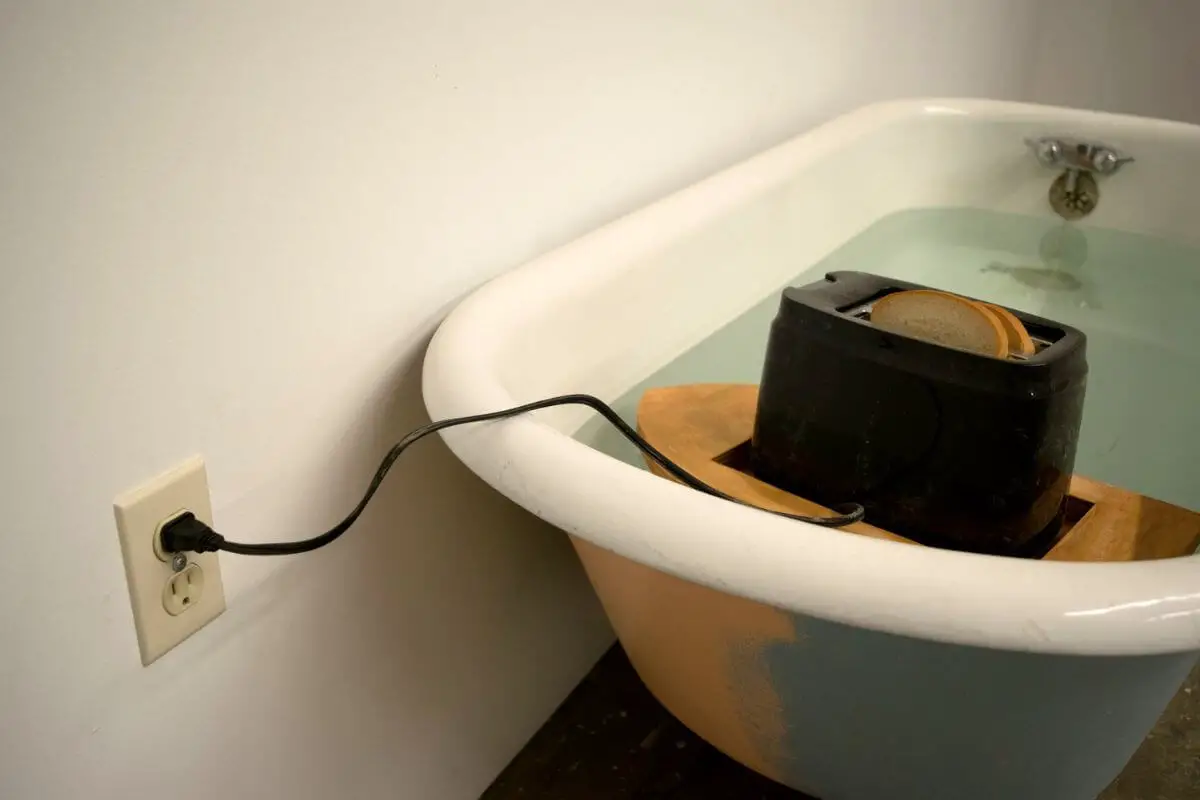The concept of putting a toaster in the bath has circulated in popular culture, often portrayed as a dangerous and potentially lethal act. However, it’s crucial to dispel this notion unequivocally: placing a toaster in the bath is an extremely hazardous and life-threatening endeavor. Let’s delve into the reasons why this myth is not only untrue but also poses a grave risk to anyone considering such an action.
The Physics of Electricity and Water: A Deadly Combination
1. Conductivity of Water:
- Water is an excellent conductor of electricity. When a toaster, plugged into an electrical outlet, comes into contact with water, it creates a direct pathway for the electric current to flow.

2. The Human Body’s Conductivity:
- The human body is also a conductor of electricity. When immersed in water, especially bathwater, the body’s conductivity increases, making it susceptible to electric shock.
3. The Outcome: Electric Shock and Drowning:
- Placing a toaster in the bath essentially turns the water into an electrified environment. If a person is in the bath at the same time, they become part of the circuit, leading to electric shock. Moreover, the combination of electric shock and water increases the risk of drowning.
Myth Origins and Media Representation:
1. Urban Legend Status:
- The notion of putting a toaster in the bath is rooted in an urban legend that has been perpetuated over time. It gained traction through word of mouth, fiction, and, unfortunately, misinformation.
2. Media Portrayal:
- Movies, TV shows, and other forms of media have occasionally depicted this act for dramatic effect. However, it’s crucial to recognize that such portrayals are fictional and should never be replicated in real life.
The Real-Life Consequences:
1. Fatal Electric Shock:
- The consequences of placing a toaster in the bath can be fatal. Electric shock can lead to cardiac arrest, severe burns, and, in extreme cases, death.
2. Legal Ramifications:
- Apart from the obvious danger to life and well-being, engaging in such activities may result in legal consequences. Deliberate actions that jeopardize safety can lead to criminal charges.
Public Safety Awareness: Debunking the Myth
1. Public Safety Announcements:
- Various organizations and authorities, including electrical safety boards and emergency services, have issued public safety announcements to debunk this myth and emphasize the extreme dangers associated with combining electricity and water.
2. Educational Initiatives:
- Educational programs and initiatives aim to raise awareness, especially among younger audiences, about the potential risks of replicating actions seen in media or heard through urban legends.
Conclusion: A Myth Best Left Unexplored
In conclusion, the idea of placing a toaster in the bath is not only a myth but a perilous act with potentially lethal consequences. It is vital to approach electricity and water with the utmost caution, recognizing the dangers they pose when combined. Public safety initiatives, educational programs, and debunking myths are essential steps in preventing misguided attempts to replicate fictional or exaggerated scenarios. The safety of individuals is paramount, and promoting accurate information is crucial to safeguarding lives and well-being.
Illuminating the Perils: Understanding the Reality of Electrical Safety
The mythology surrounding placing a toaster in the bath has been firmly debunked, but it raises broader awareness about electrical safety. Understanding the risks associated with electricity and water is paramount to ensuring the well-being of individuals in various scenarios.
The General Rule: Keep Electricity Away from Water
1. Electrical Devices and Water Don’t Mix:
- It’s a fundamental principle of electrical safety: never mix electrical devices with water. Whether it’s a toaster, hairdryer, or any other electrical appliance, using them near water sources poses a serious risk.
2. Bathroom Safety Measures:
- The bathroom, with its proximity to water sources, requires extra caution. Ensure that electrical outlets are at a safe distance from water outlets, and never use electrical devices near filled bathtubs or sinks.
Common Electrical Safety Tips:
1. Ground Fault Circuit Interrupter (GFCI) Outlets:
- Install GFCI outlets in areas where water and electricity are in close proximity, such as bathrooms and kitchens. GFCI outlets are designed to trip and cut off power if they detect a potential electrical fault.
2. Appliance Safety:
- Regularly check the condition of electrical appliances. Frayed cords or damaged plugs can pose a hazard. Replace or repair any faulty components promptly.
3. Water and Outdoor Electrical Equipment:
- Keep electrical equipment, such as extension cords or power tools, away from water sources when working outdoors. Wet conditions increase the risk of electric shock.
4. Emergency Preparedness:
- Familiarize yourself with the location of circuit breakers and how to turn off power in case of an emergency. Quick action can mitigate potential risks.
Educational Initiatives for Electrical Safety:
1. School Programs:
- Integrating electrical safety into school curricula helps educate students about the potential dangers associated with electricity and the importance of responsible use.
2. Workplace Safety Training:
- Workplaces should provide comprehensive safety training, including guidelines for handling electrical equipment and protocols for ensuring a safe working environment.
3. Public Awareness Campaigns:
- Ongoing public awareness campaigns, led by electrical safety organizations, aim to inform communities about the risks associated with electricity and water and provide guidelines for safe practices.
Conclusion: Prioritizing Safety in the Modern Age
The toaster-in-the-bath myth, while debunked, serves as a catalyst for broader discussions about electrical safety. It underscores the importance of disseminating accurate information, fostering a culture of responsibility, and implementing safety measures to protect individuals in various environments.
As technology evolves and becomes more integrated into daily life, the need for heightened awareness about electrical safety remains critical. By prioritizing education, implementing safety measures, and staying informed about potential risks, individuals can navigate the modern age safely, ensuring that electricity serves as a boon rather than a peril.
FAQS
Certainly! Here are some frequently asked questions (FAQs) related to electrical safety:
Q: Can I use electrical devices in the bathroom?
A: It’s generally not recommended to use electrical devices in the bathroom, especially near water sources. If necessary, ensure devices are positioned away from water outlets and use outlets equipped with Ground Fault Circuit Interrupter (GFCI) protection.
Q: What is a GFCI outlet, and why is it important?
A: A GFCI outlet is designed to trip and cut off power if it detects an electrical fault, preventing electric shock. They are crucial in areas where water and electricity may come into contact, such as bathrooms and kitchens.
Q: Can I use a hairdryer near water?
A: It’s unsafe to use a hairdryer near water sources. Keep electrical devices, including hairdryers, away from filled bathtubs, sinks, or wet surfaces to avoid the risk of electric shock.
Q: How often should I check my electrical appliances for safety?
A: Regularly inspect electrical appliances for signs of wear or damage. Check cords, plugs, and outlets. Replace or repair any faulty components promptly to ensure safe operation.
Q: Are extension cords safe to use outdoors?
A: When using extension cords outdoors, ensure they are rated for outdoor use. Keep them away from water sources, and never use damaged cords. Consider using ground fault circuit interrupter (GFCI) protected outlets for additional safety.
Q: What should I do in case of an electrical emergency?
A: Familiarize yourself with the location of circuit breakers and know how to turn off power in case of an emergency. If someone is experiencing electric shock, call emergency services immediately.
Q: Can I use electrical equipment in wet conditions?
A: Using electrical equipment in wet conditions increases the risk of electric shock. It’s essential to keep electrical tools and devices dry and use them in accordance with safety guidelines.
Q: How can I childproof electrical outlets in my home?
A: Install outlet covers or caps to childproof electrical outlets. Consider using tamper-resistant outlets, designed to prevent children from inserting foreign objects into the outlets.
Q: Are power strips safe to use?
A: Power strips are safe when used according to their specifications. Avoid overloading them with too many devices, and use surge-protected power strips to safeguard against electrical surges.
Q: Why is it important to turn off electrical devices when not in use?
A: Turning off electrical devices when not in use not only conserves energy but also reduces the risk of electrical fires and other potential hazards associated with prolonged device operation.
These FAQs aim to provide essential information about electrical safety, helping individuals adopt practices that prioritize safety and minimize risks associated with electricity and electrical devices.



